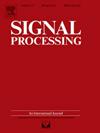一种研究NLOS测距误差上界的鲁棒TDOA定位方法
IF 3.4
2区 工程技术
Q2 ENGINEERING, ELECTRICAL & ELECTRONIC
引用次数: 0
摘要
在到达时间差(TDOA)定位中,鲁棒凸优化算法的精度受到非视距(NLOS)测距误差上界的显著影响。有些算法同时估计NLOS测距误差和源坐标,使得NLOS上界似乎没有必要,但这往往导致定位精度降低。因此,建立合理的NLOS测距误差上界至关重要。然而,现有的鲁棒优化算法在引入NLOS测距误差上界时存在一个明显的缺陷:NLOS测距误差上界的分配与实际环境不匹配,导致算法精度较差。为解决NLOS测距误差上界分配的合理性问题,创新性地将NLOS误差上界作为NLOS可变性引起的不确定变量提出。然后,我们开发了一个稳健的优化公式,使用矩阵变换来优化上界。通过应用线性化和扰动分解等技术,我们得出了调整NLOS误差上界的最优解。仿真和实验表明,该方法在近距离目标值环境下的定位精度优于现有算法。本文章由计算机程序翻译,如有差异,请以英文原文为准。

A robust TDOA localization method for researching upper bound on NLOS ranging error
In time-difference-of-arrival (TDOA) localization, the accuracy of the robust convex optimization algorithm is significantly affected by the upper bound of non-line-of-sight (NLOS) ranging error. Some algorithms estimate NLOS ranging error and source coordinates together, which makes the NLOS upper bound seem unnecessary, but this often leads to lower localization accuracy. Therefore, it is crucial to establish a reasonable upper bound for the NLOS ranging error. However, existing robust optimization algorithms suffer a significant drawback when introducing upper bounds on NLOS ranging error: The assignment of the upper bound of the NLOS ranging error does not match the actual environment, leading to poor algorithm accuracy. To solve the rationality problem of the NLOS ranging error upper bound assignment, this paper innovatively proposes the NLOS error upper bound as an uncertain variable arising from NLOS variability. We then develop a robust optimization formulation using matrix transformations to optimize the upper bound. By applying techniques such as linearization and perturbation decomposition, we derive an optimal solution that adjusts the NLOS error upper bound. Simulations and experiments show that the proposed approach outperforms existing algorithms in terms of localization accuracy in NLOS environments.
求助全文
通过发布文献求助,成功后即可免费获取论文全文。
去求助
来源期刊

Signal Processing
工程技术-工程:电子与电气
CiteScore
9.20
自引率
9.10%
发文量
309
审稿时长
41 days
期刊介绍:
Signal Processing incorporates all aspects of the theory and practice of signal processing. It features original research work, tutorial and review articles, and accounts of practical developments. It is intended for a rapid dissemination of knowledge and experience to engineers and scientists working in the research, development or practical application of signal processing.
Subject areas covered by the journal include: Signal Theory; Stochastic Processes; Detection and Estimation; Spectral Analysis; Filtering; Signal Processing Systems; Software Developments; Image Processing; Pattern Recognition; Optical Signal Processing; Digital Signal Processing; Multi-dimensional Signal Processing; Communication Signal Processing; Biomedical Signal Processing; Geophysical and Astrophysical Signal Processing; Earth Resources Signal Processing; Acoustic and Vibration Signal Processing; Data Processing; Remote Sensing; Signal Processing Technology; Radar Signal Processing; Sonar Signal Processing; Industrial Applications; New Applications.
 求助内容:
求助内容: 应助结果提醒方式:
应助结果提醒方式:


